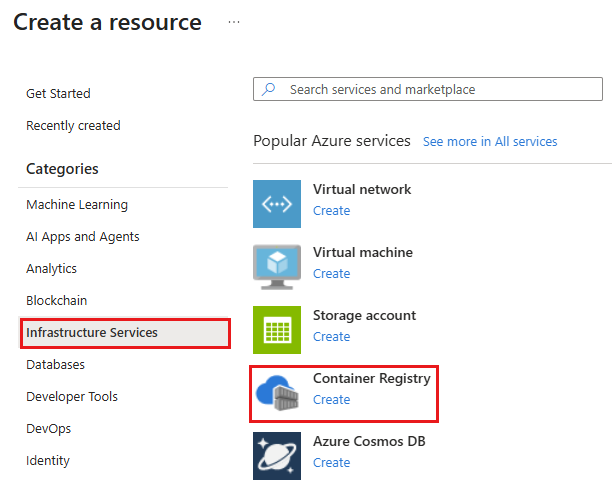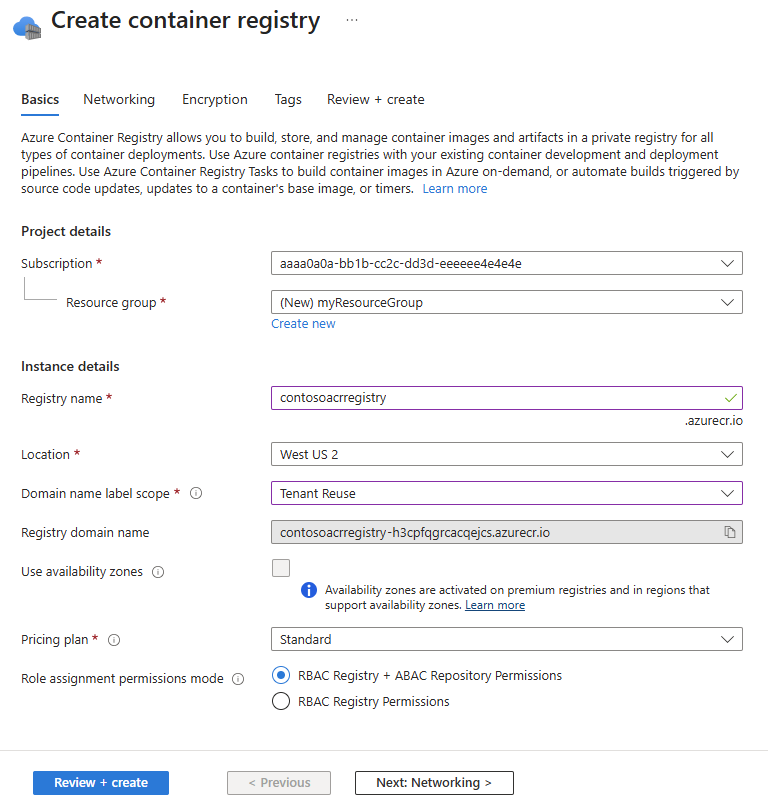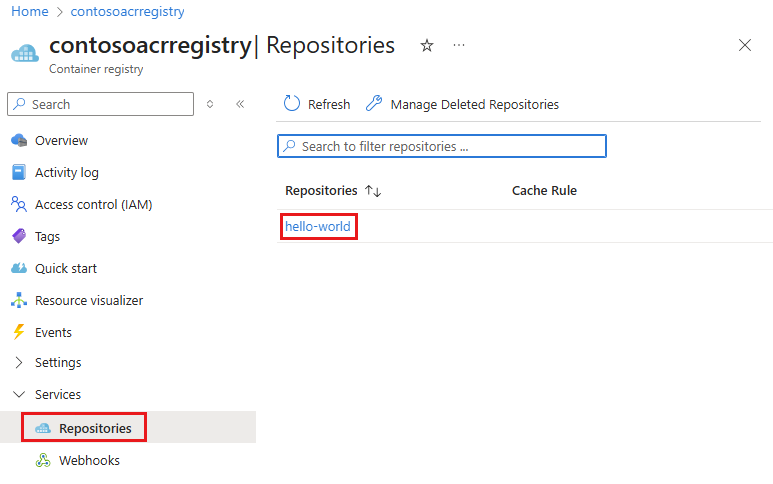Note
Access to this page requires authorization. You can try signing in or changing directories.
Access to this page requires authorization. You can try changing directories.
Azure Container Registry is a private registry service for building, storing, and managing container images and related artifacts. In this quickstart, you create an Azure container registry instance with the Azure portal. Next, you use Docker commands to push a container image into the registry. Finally, you pull and run the image from your registry.
Prerequisites
If you don't have an Azure account, create a trial subscription before you begin.
To sign in to the registry to work with container images, this quickstart requires that you run the Azure CLI, preferably the most recent version. If you need to install or upgrade, see How to install the Azure CLI.
You must also have Docker installed locally with the daemon running. Docker provides packages that easily configure Docker on any Mac, Windows, or Linux system.
Create a container registry
Sign in to the Azure portal.
Select Create a resource > Infrastructure services, then enter the Container Registry in Search services and marketplace filter of Create a resource page and select Enter key. Next, select Container Registry in search results, and finally select Create.

In the Basics tab, select the subscription where you want to create the container registry.
Select Create new to create a new resource group, and enter
myResourceGroupfor the resource group name.Enter a Registry name. The registry name must be unique within Azure, and contain 5-50 alphanumeric characters, excluding dash characters (
-). This name is part of the fully qualified DNS name of the registry.Select **China East 2 ** for Location, and for Pricing plan, select
Standard.For Domain name label scope, select Tenant Reuse, or choose another option as described in the Configure Domain Name Label (DNL) option section.
For Role assignment permissions mode, select RBAC Registry + ABAC Repository Permissions to retain standard Microsoft Entra role-based access control (RBAC) role assignments, while optionally applying Microsoft Entra attribute-based access control (ABAC) conditions for fine‑grained, repository‑level access control.

Leave the other options set to their default values, and select Review + create. After reviewing the settings, select Create.
Tip
In this quickstart, you create a Standard registry, which is sufficient for most Azure Container Registry workflows. For increased storage and image throughput, and capabilities such as connection using a private endpoint, the Premium pricing plan option (SKU) is available. For details on service tiers (SKUs), see Azure Container Registry SKU features and limits.
When the Deployment succeeded message appears, select Go to resource to view your new container registry.

Take note of the registry name and the value of the Login server, which is a fully qualified name ending with azurecr.cn in the Azure cloud.
Use the login server in the following steps when you push and pull images with Docker, as well as in downstream references such as Dockerfiles, Kubernetes YAML, and Helm charts.
Sign in to registry
Before pushing and pulling container images, you must sign in to the registry instance. Sign in to the Azure CLI on your local machine, then run the az acr login command.
Specify only the registry resource name when signing in with the Azure CLI, such as az acr login -n registryname. Don't use the fully qualified login server name, such as registryname.azurecr.cn or registryname-hash.azurecr.cn (for DNL-enabled registries).
az acr login --name <registry-name>
Example:
az acr login --name contosoacrregistry
The command returns Login Succeeded when it completes.
Push image to registry
To push an image to an Azure Container registry, you must first have an image. If you don't yet have any local container images, run the following docker pull command to pull an existing public image. For this example, pull the hello-world image from Azure Container Registry.
docker pull mcr.microsoft.com/hello-world
Before you can push an image to your registry, you must tag it by using the docker tag with the fully qualified name of your registry login server.
- The login server name format for Domain Name Label (DNL) protected registries with a unique DNS name hash included is
mycontainerregistry-abc123.azurecr.cn. - The login server name format for registries created with the
UnsecureDNL option ismycontainerregistry.azurecr.cn.
For example, if you create a registry with the Tenant Reuse DNL scope, the login server might look like mycontainerregistry-abc123.azurecr.cn with a hash in the DNS name. If you create a registry with the Unsecure DNL option, the login server looks like mycontainerregistry.azurecr.cn, without the hash.
Tag the image by using the docker tag command with your registry's login server. For this quickstart, tag the hello-world image with v1.
Example command to tag an image for a DNL-protected registry:
docker tag mcr.microsoft.com/hello-world mycontainerregistry-abc123.azurecr.cn/hello-world:v1
Example command to tag an image for a non-DNL registry:
docker tag mcr.microsoft.com/hello-world mycontainerregistry.azurecr.cn/hello-world:v1
Finally, use docker push to push the image to the registry instance. Replace <login-server> with the login server name of your registry instance. This example creates the hello-world repository, containing the hello-world:v1 image.
docker push <login-server>/hello-world:v1
After pushing the image to your container registry, remove the hello-world:v1 image from your local Docker environment by using the docker rmi command. This command doesn't remove the image from the hello-world repository in your Azure container registry.
docker rmi <login-server>/hello-world:v1
List container images
To list the images in your registry, go to your registry in the portal. Under Services, select Repositories, then select the hello-world repository you created with docker push.

When you select the hello-world repository, you see the v1-tagged image under Tags.
Run image from registry
Now, you can pull and run the hello-world:v1 container image from your container registry by using docker run:
docker run <login-server>/hello-world:v1
Example output:
Unable to find image 'mycontainerregistry.azurecr.cn/hello-world:v1' locally
v1: Pulling from hello-world
Digest: sha256:662dd8e65ef7ccf13f417962c2f77567d3b132f12c95909de6c85ac3c326a345
Status: Downloaded newer image for mycontainerregistry.azurecr.cn/hello-world:v1
Hello from Docker!
This message shows that your installation appears to be working correctly.
[...]
Clean up resources
To remove the resources you created, go to the myResourceGroup resource group in the Azure portal. Select Delete resource group to remove the resource group, the container registry, and the container images.
Configure Domain Name Label (DNL) option
The Domain Name Label (DNL) feature strengthens security by preventing subdomain takeover attacks of registry DNS names. These attacks occur when a registry is deleted, and another entity reuses the same registry name, potentially causing downstream references to pull from the registry re-created by the other entity.
DNL addresses this issue by appending a unique hash to the registry's DNS name. This approach ensures that even if another entity reuses the same registry name, the DNS names differ because of the unique hash. This safeguard prevents your downstream references from inadvertently pointing to the registry re-created by the other entity.
When you create a registry from the Azure portal, select the Domain Name Label Scope from the available options:
- Unsecure: Creates the DNS name as-is, based on the registry name (for example,
contosoacrregistry.azurecr.cn). This option doesn't include DNL protection. - Tenant Reuse: Appends a unique hash based on the tenant and registry name, ensuring the DNS name is unique within the tenant.
- Subscription Reuse: Appends a unique hash based on the subscription, tenant, and registry name, ensuring the DNS name is unique within the subscription.
- Resource Group Reuse: Appends a unique hash based on the resource group, subscription, tenant, and registry name, ensuring the DNS name is unique within the resource group.
- No Reuse: Generates a unique DNS name with a unique hash every time you create the registry, regardless of other factors, ensuring the DNS name is always unique.
Important
The DNL scope you select during registry creation is permanent and can't be modified later. This choice ensures consistent DNS behavior and prevents disruptions to downstream references.
For all DNL-enabled options except Unsecure, the DNS name follows the format registryname-hash.azurecr.cn, where the dash (-) serves as the hash delineator. For instance, a registry named contosoacrregistry with the Tenant Reuse DNL scope has a DNS name like contosoacrregistry-abc123.azurecr.cn. To avoid conflicts, the dash character (-) isn't permitted in the registry name.
If the DNS name differs from the registry name, you need to update downstream files such as Dockerfiles, Kubernetes YAML, and Helm charts to reflect the full DNS name with the DNL hash. For example, if you want your downstream Dockerfile to reference a registry named contosoacrregistry with the Tenant Reuse DNL scope, you need to update the reference to the full value such as contosoacrregistry-abc123.azurecr.cn in your downstream Dockerfile.
Next steps
In this quickstart, you created an Azure Container Registry with the Azure portal, pushed a container image, and pulled and ran the image from the registry. To continue working with Azure Container Registry, see the Azure Container Registry tutorials.